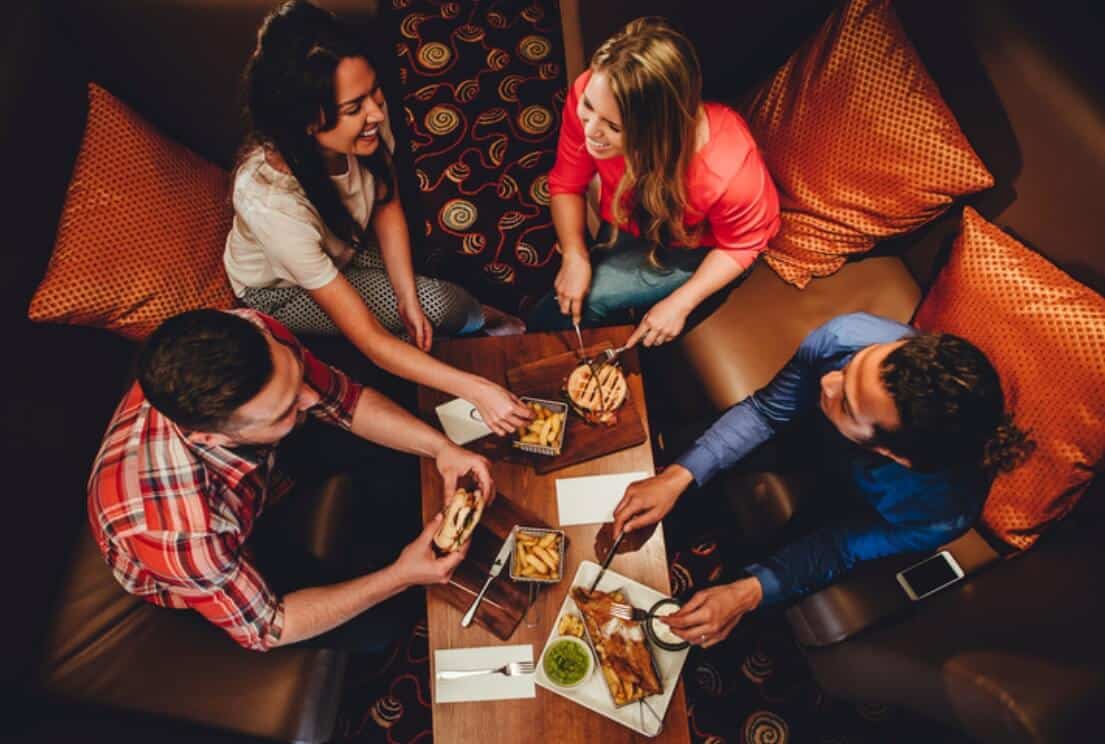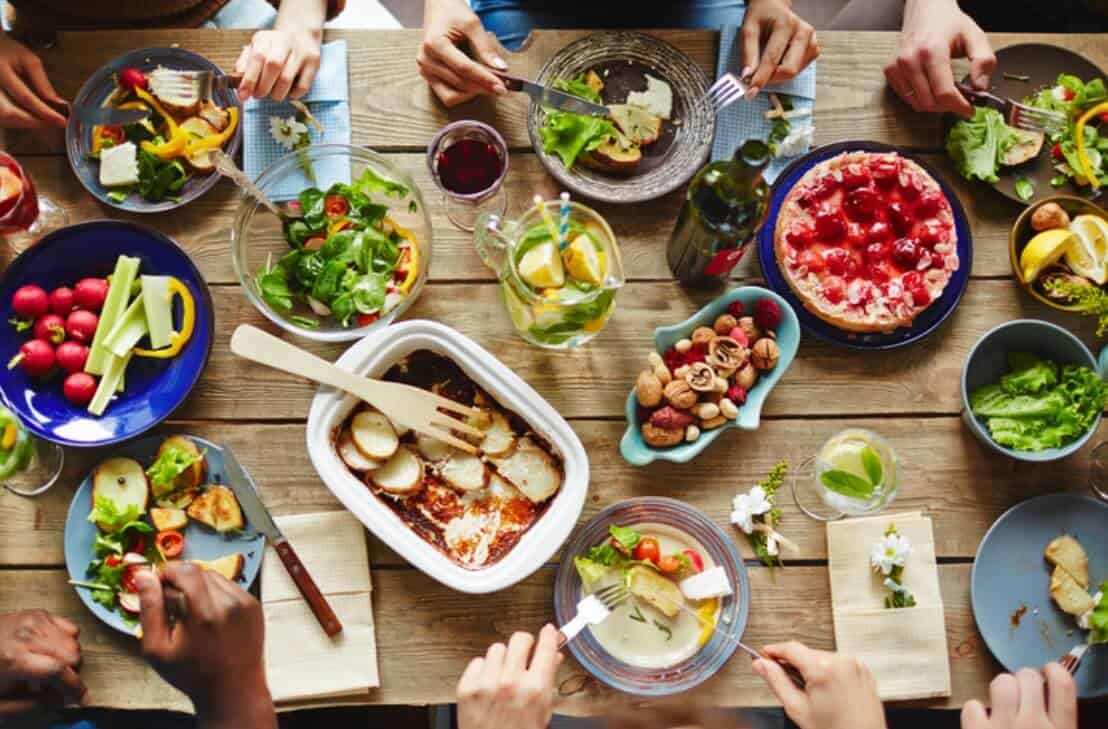How many food decisions do you think you make in a day? 5, 15, 30?
According to an Environment and Behavior article, the average person makes as many as 221 decisions related to food every day!
Those decisions you are unaware of making are the result of your subconscious making decisions for you, and that could lead to mindless eating!
Mindless eating, all those times you grab a candy from the bowl or eat an entire bag of chips while watching television, could cause you to gain weight. In fact, your mindless eating could result in a weight gain of 10 pounds each year, the Science of People writes.
Here are 11 ways you can stop yourself from engaging in mindless eating.
“In practical terms, you are the sum of your behaviors.” states Sam Yang, Fitness Coach & Martial Artist from All Out Effort.
Make it Harder to Find Things by Mindful Eating 
If you had to walk further or work harder to get your snacks, would you bother?
Scientific studies (e.g. How Visiblity and Convenience Influence Candy Consumption, Appetite Journal) suggest that you might not!
When candy dishes are moved a greater distance from the desks of office workers, they aren’t as likely to get up and grab a piece of candy as they would be if the dish were in reach.
When researchers asked participants why they didn’t get up to get candy, they said the extra steps allowed them the time to think about whether or not they really needed that candy.
Keep things like pre-cut and washed veggies on hand that you can grab and munch without much effort and get rid of unhealthy snacks that don’t require you to do any work to eat them.
Can mindless eating hurt your weight-loss efforts? Try tracking your food intake with an app like Noom to see what you’re eating and where you can improve.
Summing It Up:
If you make snacking more difficult, you’ll have to think about it before you pop that bite of food into your mouth, which could help curb mindless eating.
Concentrate on Mindful Eating 
Do you watch television while you eat or play games on your smartphone or tablet? That can lead to eating more and still not feeling full, research in the British Journal of Nutrition and The American Journal of Clinical Nutrition suggest.
In one study, researchers split participants into three groups: group one played a computer game while eating and would receive money if they won; group two played while eating with no incentive; and group three just ate.
The results showed that those in group one, who were distracted the most, ate 69% more than those who did not play while eating and group one, who were mildly distracted, ate 28% more, The Medical Daily reports.
Another study showed that if you mindful eat while watching television, longer shows will cause you to eat more than shorter shows.
People who watched a one hour show, as reported in one study in Appetite, ate 28% more than people watching a half hour show.
Distracted eating can cause you to forget how much you’ve eaten, says WebMD.
Summing It Up:
When you eat, JUST eat! Don’t pick up your smartphone or switch on the television. You’ll eat less and feel fuller. “One easy way to eat more intuitively is to begin to think about how you see different types of food. Do you think of some as “good” and some as “bad?” If so, how do you feel when you eat those? After so much time being on a diet or eating in a restrictive way, it’s easy to see how emotions like guilt and shame can come from eating something as simple as a cupcake. When really, it’s just a cupcake! Try removing those mental labels as much as you can. When you stop moralizing food, then it’s easier to get out of that all-or-nothing mindset. Instead, you can slow down, enjoy your food and be mindful.” states Jennipher Walters, CEO and Co-founder of Fit Bottomed World LLC.
Mindful Eat out of Hunger, Not Just Because It’s a Certain Time 
If you watch the clock to decide when to eat next, you may be overeating.
One study in the Journal of Personality and Social Psychology indicated that people who eat when the clock reaches a certain time will eat more often than people who rely on cues from their bodies to determine when to eat.
In the study, people were placed in a room with no windows and a clock that was set to run faster than normal.
The scientists discovered that the people who watched the clock for when to eat next, ate more often than those who listened to their bodies.
Another interesting outcome from that study was that people who were obese and thought they were eating after their normal dinner time ate more than if they thought they were eating before their usual time.
Some medical professionals suggest that in order to get into the habit of listening to your body’s hunger cues, you should rate the level of hunger – zero is ravenous and five is over-stuffed, writes WebMD.
Summing It Up:
Eating at regulated times according to the clock could cause you to overeat. Instead, listen to your body’s cues and decide if you really are hungry before you sit down to a meal. “Zero in on your overeating triggers. These triggers are different for everyone: For many of us, the most likely triggers are thoughts that create feelings of stress, loneliness, and for some of us, even happiness.” states Michele Lian.
Remember to log foods in Noom when you eat them. Waiting until later in the day may leave you wondering what you ate. Log soon, log often.
Storing Extra Food May Not be the Best Idea 
You see a good deal on one of your favorite foods in the supermarket or at one of those bulk shopping stores, so you buy a lot of it, right? Unfortunately, having those foods around in quantity could make you overeat, suggests research done by the American Marketing Association.
One of the reasons we may eat too much when we have lots of food on hand is that we worry about wasting it, writes The Medical Daily.
One study in Obesity conducted on college students showed that students who were given twice as many snacks as another group consumed 81% more calories than those who received fewer snacks.
Summing It Up:
Rather than buying foods [especially snack foods!] in bulk, purchase only what you need and can reasonably consume between your usual shopping trips.
Pick Your Dinner Dates with Care
Did you know that you’ll eat less if you eat alone? Studies (e.g. Physiology & Behavior) show that dining with even one person can increase the amount you eat by as much as 35% and up to 96% with larger groups of seven or more.
When you eat alone you are more likely to eat less and make healthier food choices than you would when you eat with friends or family.
Eating alone is no longer considered abnormal because today about half of the meals and snacks people eat are eaten alone, writes The Washington Post.
You can’t always avoid eating with other people, and probably don’t want to. But, if you eat with people who make healthy choices or eat less, you’re likely to mirror their eating habits.
One way you can curb your eating when you dine at home with others is to trick your eyes into thinking your portion size is larger than it is.
Use smaller dishes. One study showed that campers given larger cereal bowls ate 16% more than those with smaller bowls, but they estimated that they ate less.
Another study showed that the color of the plates we use can affect how much we eat. The results of the study indicated that bright red plates help us to eat less, Women’s Health Magazine reports.
Summing It Up:
Eating alone is the best course of action for eating less, but when you do eat with others, there are tricks you can use to help you eat less. Use smaller dishes and choose red ones whenever possible.
Think Food Volume to Get Fuller, Faster 
If what you eat looks like a lot of food, regardless of the amount of calories, you’ll feel fuller and eat less.
Scientists (Psychosomatic Medicine) studied this idea by providing participants with smoothies. One group of people received a smoothie with air added to it so that it looked bigger.
The calorie count of the smoothie for both groups was the same.
The group that received the larger looking smoothies reported feeling fuller and they consumed 12% less food the next time they ate.
Of course, adding air to food isn’t always an option, so to feel fuller with fewer calories, try adding fiber to your diet instead, advises The Mayo Clinic.
Fiber, found in products like 310 Shake, is necessary to maintain health,but most people only eat 15 grams of fiber per day. However, the recommended amount of fiber is 25 grams for women and 38 grams for men, says WebMD.
Besides helping you stay fuller longer, fiber is also good for your heart and can help reduce cholesterol levels, adds WebMD.
According to Women’s Health Magazine and The Mayo Clinic, some high-fiber, low-calorie foods to consider adding to your diet include: hummus, oatmeal, lentils, popcorn, carrots, apples, and oranges.
How do you know if the foods you’re eating are high fiber? Take some time to log your meals each day with Noom, so you see all the nutrition facts in one place.
Summing It Up:
Look for high volume, low calorie foods to help you feel fuller longer. Choose foods with lots of fiber to add volume without extra calories.
Health Foods May not be that Healthy 
You might think you’re doing your body good when you choose so called “health food” labeled “low-fat,”. But, these foods could lead to more mindless eating.
Those “low-fat” products available in stores are sometimes no lower in calories and they’re often loaded with sugar to improve the taste, according to Health.com.
One study showed that 10% of low-fat products had the same number of calories as their non-diet counterparts, and 40% of them contained more sugar.
One study showed that people tend to eat more when they think what they are eating is low-fat.
Participants in two groups were offered chocolates labeled “regular” or chocolates labeled “low-fat.” Those who ate the “low-fat” chocolates ate around 33% more than those who ate the “regular” chocolates.
Scientists believe this is because people feel less guilty when they choose foods labeled “low-fat”, Medical News Today writes.
Researchers (Journal of Consumer Research) studied the calories eaten by people who ate food from Subway restaurants and those who ate food from McDonald’s restaurants. The people who ate at Subway thought they had eaten about 34% fewer calories than they had while the people who ate at McDonald’s thought they had eaten 25% more.
The researchers also noticed that when people eat at Subway, they tend to order unhealthy side items like cookies or chips as a way of rewarding themselves for making a healthy choice for their main course.
Researchers call this kind of mindless eating the “halo effect.”
To prevent yourself from indulging in the “halo effect,” choose your foods by considering the ingredients and reading the labels rather than by the way the food is advertised.
Summing It Up:
Often times the foods that manufacturers label as healthy really aren’t. Read the labels when you shop and avoid choosing unhealthy sides when you order a healthy main course.
Too Many Options Leads to Mindless Eating 
Having many different types of food available may make you eat more than if you have only a few.
It’s called sensory-specific satiety which occurs when a person experiences a short-term reduction in enjoyment after eating enough of one type of food. When people reach this point, they simply don’t want more of the food they were eating.
In one Appetite study, researchers gave participants a certain amount of chocolate milk to drink. Afterward, the group was divided into two and asked to play a game in order to receive more chocolate milk or crisps.
The group that was offered crisps proved to be more motivated to perform better. Participants also indicated a reduction in the liking of the smell or taste of the chocolate milk.
These results show that sensory-specific satiety is linked to both not liking and not wanting any more of a certain food.
Due to sensory-specific satiety, having a meal with a lot of variety may cause you to eat more than if you stick to just a few foods in your meal.
Summing It Up:
Limiting the variety of foods available to you may help you eat less. To use sensory-specific satiety to your advantage, avoid having too many snack foods on hand to choose from and limit your meals to only a few different foods.
Think Small Packaging 
Mindless eating can be caused by eating from larger packages.
When you eat from a larger package, you may eat up to 25% more calories than you would from a smaller package.
One study proved this by giving people either a 16 ounce bag of M&Ms or an 8 ounce bag of M&Ms. The people with the bigger bags ate an average of 66 more M&Ms than those with the smaller bags.
Our impulse to purchase larger packages of food is linked to our desire to get a good deal. But, the truth is that when we buy smaller packages, like Plexus Slim, we eat less food regardless of the actual volume of the food contained in the package, Critical Reviews in Food Science and Nutrition and INSEAD research suggest.
One way to limit this kind of mindless eating is to pay attention to serving sizes on the packaging. Those snack-sized bags offered in vending machines often contain more than one serving.
Rather than eating right from the package, measure out a serving size and put the rest away, advises the CDC.
Mindless eating doesn’t have to be a problem holding you back from losing weight. Take an app like Noom, start tracking your meals, and see just what you’re eating everyday.
Summing It Up:
Don’t be fooled into mindless eating by larger packaging. Choose smaller packages and pay attention to serving sizes.
Don’t Look at Food Every Day 
If you keep food where it’s visible, you’re more likely to engage in mindless eating.
Studies from the American Marketing Association have shown that when the container or package of food is see-through and the food is small and appealing, people will eat more.
One study in the International Journal of Obesity showed that when a clear candy bowl is placed in an office, people will reach into the bowl 71% more than if the bowl were opaque.
You can use this phenomenon to your advantage by hiding unhealthy treats where you cannot see them, but placing healthy snacks like fruit and vegetables within sight.
Summing It Up:
Put your unhealthy treats and snacks where you can’t see them to keep yourself from mindlessly reaching for them.
Slow Down, Take Your Time 
If your mom told you to slow down when you were eating, she was right! Eating more slowly can help you to eat less.
When you eat too fast, you eat more than you need to before your body can tell you that it is full, says WebMD.
Eating more slowly can allow your body the time it needs to let you know you’ve eaten enough before you mindlessly reach for that second helping, states The Journal of Clinical Endocrinology and Metabolism.
Another benefit of eating slowly is that you’ll enjoy your meal more. When you take your time, your body is more able to enjoy the taste, smell, and textures of the foods you eat and you’ll feel more satisfied, adds WebMD.
Summing It Up:
Be aware of how fast you’re eating and try to slow down. You’ll give your body the time it needs to tell you that it’s full and you’ll enjoy your meal more.
What Users Are Saying
“It’s funny that brushing your teeth is one of the ways to stop you from eating snacks because my sister would always tell me to do that when we were in high school and really watching our weight. It really works!”
“I battle with binge eating disorder and this lockdown and coming winter is not helping. Until I discovered drinking a teaspoon of bovril with hot water. It is meaty, brothy salty hugging cup of warmness that resembles a weak soup almost. Unfortunately high in sodium but it helps!!! Life saver for me.”
“I did this too. I struggle with binge eating as well and lack any kind of discipline. Decided to go vegan just as an exercise to practice self-discipline. It can be cumbersome, but I’m really happy with the results. Feel better, have lost weight, skin looks better, I have more energy, don’t feel like a glutton. It’s such a strict and big change that you’re super conscious of everything that goes into your mouth at first, but then ends up feeling really normal. You even start craving Daiya products (which at first taste like disappointment).”

What You Need to Know about Mindless Eating:
Mindless eating can lead to weight gain or the inability to effectively lose weight.
When you eat mindlessly, you eat more calories than you should and make food choices that are not as healthy.
“Cooking large quantities of food and portioning it out to be saved for the week (aka “meal prepping) is the key to reaching any health/fitness goal. There are levels to the meal prepping game but the steps for a first-time cooker would be grocery shopping, cooking a protein (meat, fish, quinoa, etc), vegetables (broccoli, asparagus, cauliflower, etc) and carbohydrates (rice, quinoa, etc.) all during the same 2-3 hour time frame. Once everything is cooked, I like to weigh out my portions, so 6-7 oz of protein, 3-4 oz veggies, and 3-4 oz carbs then place the three foods in separate plastic or glass containers. I got into this habit when I worked a desk job and didn’t have time to cook dinner when I got home. Now as a personal trainer, a standard meal prep these days is 6-8 meals which would last me 3-4 days of lunch and dinner.” states Mark Barroso, NSCA-CPT, Spartan SGX Coach, and health writer.
To avoid mindless eating, follow these 11 simple tips.
Want to make these tips into repeatable habits? Concentrate on making a few small changes at a time and expect to work toward forming your new healthy habit for at least two months and track your meals with an app like Noom.
11 Tips to End Mindless Eating for Good – Says Science Questions & Answers
- Recent:
Tricking your mind into eating less may sound difficult but it is achievable with the right strategies. Here are a few tips to get started:
- Drink plenty of water before meals: Drinking water before meals can help reduce hunger and keep you feeling full for longer.
- Eat slowly: Eating slowly allows your body time to recognize when it’s full, so you don’t overeat.
- Distract yourself while eating: By watching television, playing video games, or doing other activities that take your mind off food, you’ll be less likely to overeat.
- Visualize fullness: Before eating a meal, visualize yourself already being satisfied after the meal has been finished. This will help prevent overeating.

Summer Banks has researched over 5000 weight-loss programs, pills, shakes and diet plans. Previously, she managed 15 supplement brands, worked with professionals in the weight loss industry and completed coursework in nutrition at Stanford University.











